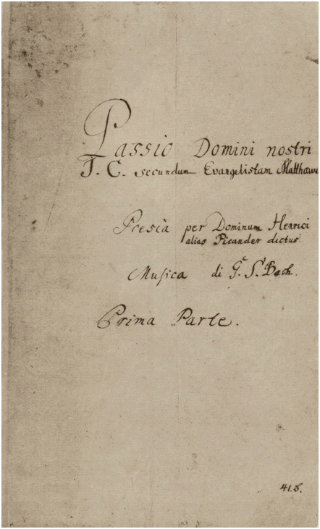
The St Matthew Passion, BWV 244, is a Passion, a sacred oratorio written by Johann Sebastian Bach in 1727 for solo voices, double choir and double orchestra, with libretto by Picander. It sets the 26th and 27th chapters of the Gospel of Matthew to music, with interspersed chorales and arias. It is widely regarded as one of the greatest masterpieces of Baroque sacred music. The original Latin title Passio Domini nostri J.C. secundum Evangelistam Matthæum translates to "The Passion of our Lord J[esus] C[hrist] according to the Evangelist Matthew".
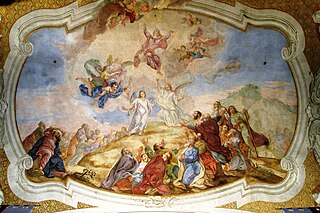
Lobet Gott in seinen Reichen, BWV 11, known as the Ascension Oratorio, is an oratorio by Johann Sebastian Bach, marked by him as Oratorium In Festo Ascensionis Xsti, composed for the service for Ascension and probably first performed on 15 May 1738.

The cantatas composed by Johann Sebastian Bach, known as Bach cantatas, are a body of work consisting of over 200 surviving independent works, and at least several dozen that are considered lost. As far as known, Bach's earliest cantatas date from 1707, the year he moved to Mühlhausen, although he may have begun composing them at his previous post in Arnstadt. Most of Bach's church cantatas date from his first years as Thomaskantor and director of church music in Leipzig, a position which he took up in 1723.

Jesus nahm zu sich die Zwölfe, BWV 22, is a church cantata by Johann Sebastian Bach composed for Quinquagesima, the last Sunday before Lent. Bach composed it as an audition piece for the position of Thomaskantor in Leipzig and first performed it there on 7 February 1723.

Darzu ist erschienen der Sohn Gottes, BWV 40, is a church cantata by Johann Sebastian Bach. He composed it in 1723, his first year in Leipzig, for the Second Day of Christmas, and first performed it on 26 December that year in both main churches, Thomaskirche and Nikolaikirche. It was the first Christmas cantata Bach composed for Leipzig. The title of the cantata also appears in more modern German as Dazu ist erschienen der Sohn Gottes.

Vox Christi, Latin for Voice of Christ, is a setting of Jesus' words in a vocal work such as a Passion, an Oratorium or a Cantata. Conventionally, for instance in Protestant music of the Baroque era, the vox Christi is set for a bass voice.

Sie werden aus Saba alle kommen, BWV 65, is a church cantata by Johann Sebastian Bach. He composed it in 1724 in Leipzig for Epiphany and first performed it on 6 January 1724 as part of his first cantata cycle.
As Thomaskantor, Johann Sebastian Bach provided Passion music for Good Friday services in Leipzig. The extant St Matthew Passion and St John Passion are Passion oratorios composed by Bach.

Sehet, wir gehn hinauf gen Jerusalem, BWV 159, is a church cantata by Johann Sebastian Bach. He composed it in Leipzig for the Sunday Estomihi, the last Sunday before Lent, and probably first performed it on 27 February 1729. The gospel reading for the Sunday, from the Gospel of Luke, includes Jesus announcing his suffering and death in Jerusalem. The cantata's theme and Bach's music foreshadow his Passion.

Jesus Christus ist um unsrer Missetat willen verwundet is a St Mark Passion which originated in the early 18th century and is most often attributed to Reinhard Keiser. It may also have been composed by his father Gottfried or by Friedrich Nicolaus Bruhns. Johann Sebastian Bach produced three performance versions of the Passion, the last of which is a pasticcio with arias from George Frideric Handel's Brockes Passion. There are two other extant 18th-century versions of the Passion, both of them independent of Bach's versions. The Passion was performed in at least three cities in the first half of the 18th century: in Hamburg in 1707 and 1711, in Weimar around 1712, and in Leipzig in 1726 and around 1747.

Er rufet seinen Schafen mit Namen, BWV 175, is a church cantata by Johann Sebastian Bach. He composed the cantata in Leipzig for the third day of Pentecost and first performed it on 22 May 1725.
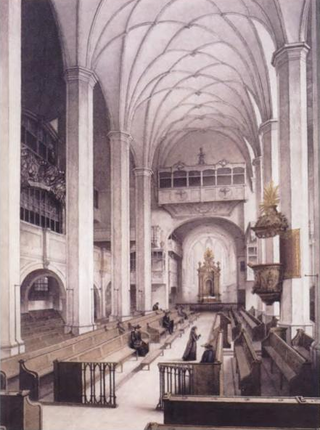
Meinen Jesum laß ich nicht, BWV 124, is a church cantata written by Johann Sebastian Bach. He composed the chorale cantata in Leipzig for the first Sunday after the Epiphany and first performed it on 7 January 1725. It is based on the hymn "Meinen Jesum laß ich nicht" by Christian Keymann.
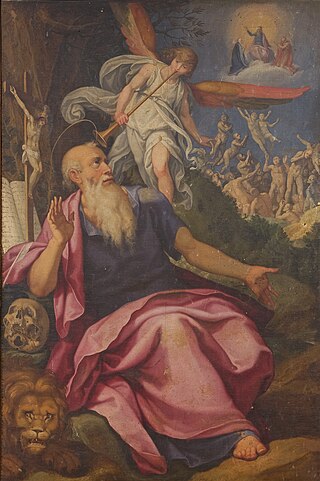
Herr Jesu Christ, wahr' Mensch und Gott, BWV 127, is a cantata by Johann Sebastian Bach for use in a Lutheran service. He composed the chorale cantata in 1725 in Leipzig for the Sunday Estomihi, the Sunday before Lent. It is based on Paul Eber's 1582 hymn in eight stanzas "Herr Jesu Christ, wahr Mensch und Gott". Bach first performed it on 11 February 1725.

Johann Sebastian Bach's St Matthew Passion, BWV 244, is structured on multiple levels: the composition is structured in three levels of text sources and by the different forms that are used for musical expression.
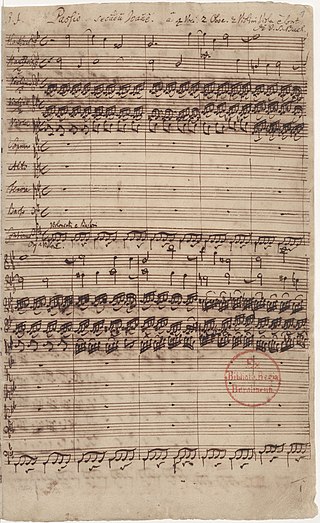
The structure of the St John Passion, BWV 245, a sacred oratorio by Johann Sebastian Bach first performed in Leipzig on Good Friday 1724, is "carefully designed with a great deal of musico-theological intent". Some main aspects of the structure are shown in tables below.
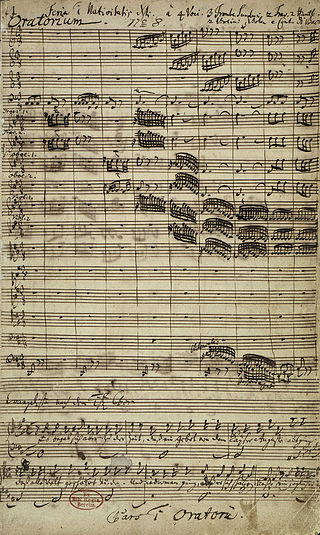
Jauchzet, frohlocket! Auf, preiset die Tage, BWV 248I, is a 1734 Christmas cantata by Johann Sebastian Bach that serves as the first part of his Christmas Oratorio. Bach was then Thomaskantor, responsible for church music at four churches in Leipzig, a position he had assumed in 1723. For the oratorio, the libretto by an unknown author followed the nativity of Jesus from the Gospel of Luke, interspersed with reflecting texts for recitatives and arias, and stanzas from Lutheran hymns.

Fallt mit Danken, fallt mit Loben, BWV 248IV, is a Christmas cantata by Johann Sebastian Bach, composed in 1734 as Part IV of his six-part Christmas Oratorio. Each part of the oratorio is a cantata, written for performance on one of the feast days of the Christmas period. Fallt mit Danken, fallt mit Loben is meant for the New Year's Day feast of the circumcision and naming of Jesus. Based on a libretto by an unknown author, it tells the naming of Jesus from the Nativity of Jesus, according to the Gospel of Luke.

Und es waren Hirten in derselben Gegend, BWV 248II, is a 1734 Christmas cantata by Johann Sebastian Bach as the second part of his Christmas Oratorio. Bach was then Thomaskantor, responsible for music at four churches in Leipzig, a position he had assumed in 1723.
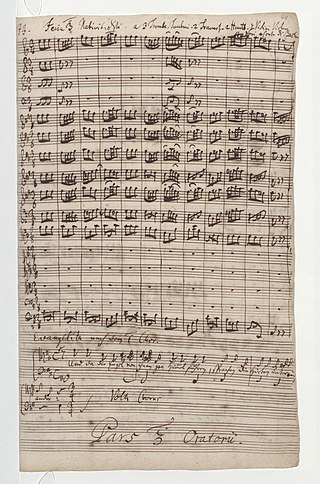
Herrscher des Himmels, erhöre das Lallen, BWV 248III, is a 1734 church cantata for the third day of Christmas (27 December) which Johann Sebastian Bach composed as the third part of his Christmas Oratorio. The Christmas cantata was first performed in 1734, in Leipzig. Bach was then Thomaskantor, responsible for music at four churches in Leipzig, a position he had assumed in 1723.
St Mark Passion is a Passion, written in baroque style by Nikolaus Matthes (*1981) between April 2019 and April 2020. It describes the passion, death and sepulture of Jesus. It contains the entire text of chapters 14 and 15 of the Gospel of Mark.


















